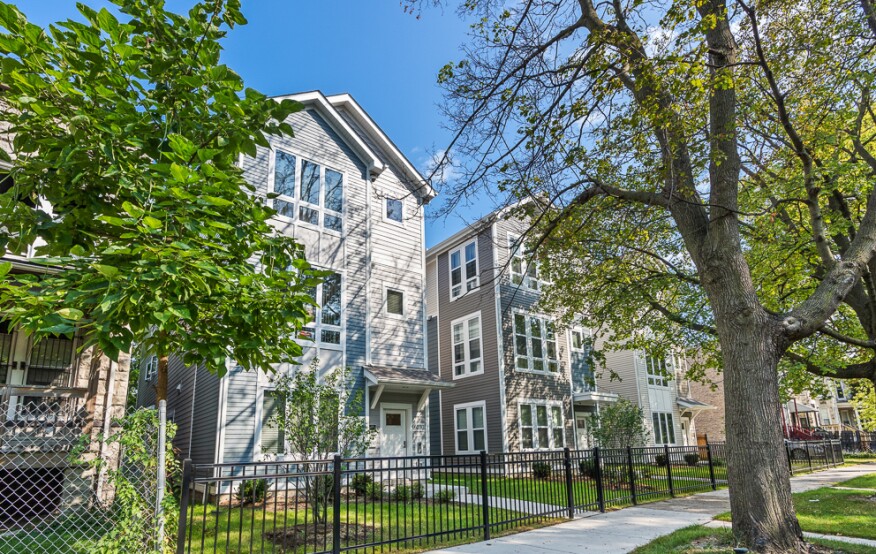
VOA Illinois, an affiliate of national nonprofit Volunteers of America, is working to rebuild Chicago’s Englewood neighborhood one block at a time.
Once a community full of vitality, the neighborhood was hit by a confluence of factors that drove down population followed by disinvestment, leaving a significant number of vacant lots and abandoned homes and buildings.
VOA Illinois came into Englewood and built Hope Manor II, a 73-unit permanent supportive housing campus serving veterans and their families, in 2014. President and CEO Nancy Hughes Moyer, who has a social worker background, would walk the blocks around Hope Manor II and see the many vacant lots and homes. She says she would think about how that view of such abandonment would impact a child’s perspective walking to and from school.
“I couldn’t get that out of my mind, that was it,” she says. “I didn’t know how I would pull it off or the pathway, but I knew we had to make that better.”
VOA Illinois came up with a grand vision to make a difference in Englewood with three levers: reducing vacant lots, reactivating abandoned residential structures, and taking on some high vacancy on the commercial corridor.
The first significant strategy was with scattered-site infill development of vacant lots in the surrounding blocks around Hope Manor II. Completed this spring, the first phase of Hope Manor Village replaced 16 vacant lots with 36 two-bedroom apartments; 14 units serve residents at 60% of the area median income (AMI), 12 units at 50% of the AMI, five units at or below 30% of the AMI, and five units at or below 15% of the AMI. Ten units for the lowest-income households also have housing vouchers through the Chicago Low-Income Housing Trust Fund’s MAUI program.
For these efforts, Hope Manor Village is the overall winner in Affordable Housing Finance’s annual Readers’ Choice Awards for the nation’s top developments of 2020 and 2021. Magazine and newsletter subscribers also voted the project as the best urban development.

“We were able to show people with Hope Manor Village that if you build high-quality, affordable housing in a community that is struggling with disinvestment and significant population loss, you can keep people there who might have otherwise left and you can bring back people who had already left.”
Hughes Moyer says while on paper it doesn’t look like it’s a big project, its impact is significant.
“It was a huge investment in time, energy, and resources at every level of our organization to get this across the finish line. It’s creating 36 homes where previously there was nothing but overgrown lots with weeds, debris, and rats. Its impact on the fabric of the community right there on those blocks is significant,” she says. “While the project may seem smaller based on the total number of units created within each building, the impact on each of those blocks is transformative. It’s an unconventional approach to developing affordable housing, which tends to favor large-scale, high-density buildings, but it’s really important work that needs to be done to really move the needle on historic disinvestment and change the dynamic at the community level.”
She says when you start to address these systemic problems in a scalable way but on a block-by-block level, it will have a positive effect on the quality of lives for everyone on that block by creating more community safety and increasing property values.
“When there is a high concentration of vacant lots and abandoned buildings on a residential street, it attracts the kind of negative activity that creates instability and makes people feel unsafe in their own neighborhood. When you fill those vacant lots in and start reactivating abandoned homes, that block is no longer useful to people who are engaging in criminal activity,” she says.
To make the project a reality, the city of Chicago donated the 16 vacant lots. Financing for the $14.5 million development included low-income housing tax credits allocated by the Illinois Housing Development Authority, with National Equity Fund as the syndicator. Additional funding was provided by the Chicago Department of Housing, Local Initiatives Support Corp., the Chicago Low-Income Housing Trust Fund, the Federal Home Loan Bank of Chicago, BMO Harris Bank, Fifth Third Bank, Capital One, and The Home Depot Foundation. The project also benefited from Opportunity Zone funds.
Additional partners in the development include architect Worn Jerabek Wiltse Architects and general contractor Safeway—JJ Duffy Joint Venture.
VOA Illinois has more work to do in the neighborhood. The next two phases of neighborhood revitalization will be focused on rehabbing abandoned and foreclosed properties as well as Englewood 21, a learning and development center that will host after-school programs, a teen technology center, and small business enterprises.
“Our hope is that this project will create the necessary momentum for others to see the great potential in this community and bring their development plans here too. Our work with Hope Manor Village is certainly having a positive and catalytic effect, but it’s certainly a bit slower than we hoped with the twin disasters of COVID and the unsettling rise in gun violence on the South Side over the past 12 months,” says Hughes Moyer. “Those challenges don’t deter us though, they make our call to action even more urgent. We will never take our foot off the gas even when the obstacles seem to be getting bigger—we need to press harder during this time knowing that other people will follow if we continue to show up and prove to the community that we are here to stay.”









